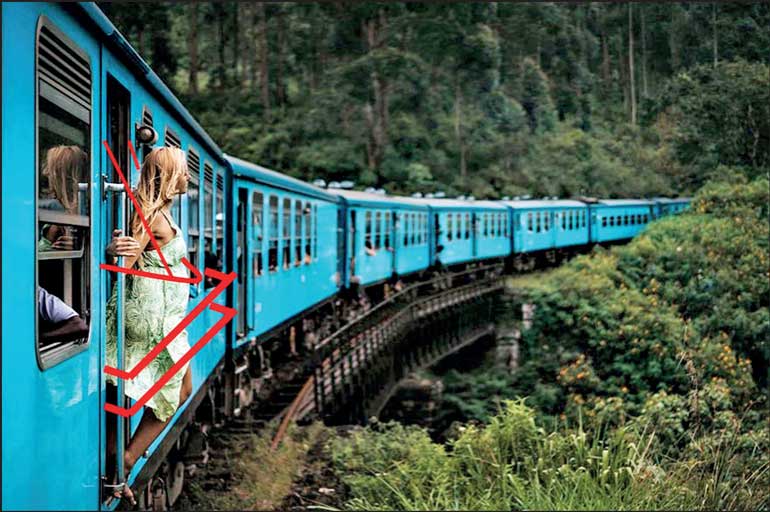Tuesday Apr 22, 2025
Tuesday Apr 22, 2025
Wednesday, 27 October 2021 00:00 - - {{hitsCtrl.values.hits}}

Raquel and Miguel, Ella train
Before the COVID pandemic hit, there was some debate and concern voiced about tourists standing in the doorways of trains and even hanging out while the train is moving. Some pictures of a young couple hanging out of upcountry train, while clutching on to the side rails, went viral on social media with debates of the ‘pros’ and ‘cons’ reaching fever pitch. While this is certainly a dangerous practice, not to be condoned, if we ‘think out of the box’ could there be a way to turn this seemingly popular though dangerous pastime among some tourists into an opportunity to be exploited? This article aims to explore these options pragmatically
 Social media, and even some of the more conventional media, were all abuzz before the COVID crisis when some pictures of a young tourist couple appeared hanging out of the Sri Lankan upcountry train in gay abandon, savouring the exciting moment.
Social media, and even some of the more conventional media, were all abuzz before the COVID crisis when some pictures of a young tourist couple appeared hanging out of the Sri Lankan upcountry train in gay abandon, savouring the exciting moment.
There were hot debates about this form of ‘promotion of Sri Lanka,’ with many people talking about the dangers of such a practice, and that it would bring negative publicity for Sri Lanka if something dangerous were to happen. This part of the train ride along the upcountry route is arguably one of the most scenic train routes in the world. And quite rightly so I guess. I myself was one who joined the chorus who vehemently spoke against this.
However, thinking out of the box, I got thinking: Can we create an opportunity here?
The ‘new’ experience and thrill-seeking tourist of today
There is no doubt that there is a new segment of discerning, younger, experience and adventure seeking tourists, emerging and travelling all over the world. They are very internet and social media savvy, seeking more adventurous and exciting experiences, and are usually very environmentally conscious. They are most often seen exploring ‘off-the-beaten-track’ holidays, planned out individually according to their needs and wants.
Through the ages, mankind has been pushing the limits of exploration: we have conquered the land, sea and space. We have discovered many hitherto unknown wonders of our planet with our unabated thirst for knowledge.
Tourists are no different. To get away from their daily stressful daily life, they seek something different, even venturing into hostile or dangerous places to experience the excitement of discovery and the feeling of adventure. No longer is a clean hotel room with a range of facilities, good food and some sunshine good enough for a tourist.
According to booking.com, the yearning for experiences over material possessions continues to drive travellers’ desire for more incredible and memorable trips: 45% of travellers have a bucket list in mind. Most likely to appear on a bucket list are thrill seekers wanting to visit a world famous theme park, travellers looking to go on an epic rail journey or visiting a remote or challenging location. (https://globalnews.booking.com/eight-travel-predictions-for-2018-as-revealed-by-bookingcom/)
Drive reduction theory in psychology postulates that one is never in a state of complete fulfilment, and thus, there are always drives that need to be satisfied. Humans and other animals voluntarily increase tension by exploring their unknown environments, self-inducing stress and moving out of their comfort zones. This gives them a sense of achievement and self-satisfaction (https://www.psychestudy.com/general/motivation-emotion/drive-reduction-theory). Therefore unknown thrills, adventures and the ‘adrenaline rush’ does attract travellers.
What have other countries done?
As mentioned, many countries are developing unique, memorable and thrilling experiences into their product offering. A few are described below:
Walk along Sydney Harbour Bridge: Small groups are taken on a walk along the massive, arched steel structured Sydney Harbour Bridge. The dramatic 360 degree view from the bridge, 135 meters above ground, of the harbour, and the nearby Sydney Opera House, while being completely exposed to the elements, is indeed a rare and thrilling experience. https://www.bridgeclimb.com/
Coiling Dragon Cliff skywalk, Zhangjiajie, China: In the northwest of China's Hunan province, visitors can take a leisurely stroll along the walkway attached to Tianmen Mountain — 4,700 feet above the ground. The glass-bottomed walkway is more than 300 feet long and only about five feet wide, providing an experience that is said to be exhilarating and frightening. https://www.lonelyplanet.com/news/2016/08/02/100-meter-long-coiling-dragon-cliff-skywalk-opens-public/
The CN Tower Edge Walk, Canada: The tallest attraction in Toronto lets people stand right at the edge of the CN tower and lean over. It is the world’s highest full circle, hands-free walk on a 1.5 m wide ledge encircling the top of the Tower’s main pod, 356m, 116 storeys above the ground. EdgeWalk is a Canadian Signature Experience and an Ontario Signature Experience. https://www.businessinsider.com/terrifying-tourist-attractions-2016-9/?r=AU&IR=T/#willis-tower-chicago-11
Gorilla safaris in Rwanda: A variety of unique trekking opportunities in Rwanda and Uganda allow you trek into the jungle to gaze into the eyes of the gorillas in their natural habitat. It’s a completely unique African safari experience. This moment leaves a lasting and unforgettable impression coming so close to this majestic wild animal. https://www.responsibletravel.com/holidays/rwanda
These are just a few. So there are already a range of unique, visitor attractions that thrill tourists the world over.
Safety, the one overriding condition
All these thrill seeking and seemingly dangerous tourist attractions have one common denominator that is never ever compromised – Safety. Safety is of paramount importance in all these activities and are subject to stringent checks and review periodically. All personnel who guide and instruct these thrill seeking tourists are well trained and disciplined.
Any equipment that is used for safety such as harnesses and safety belts are designed to the highest standards and are periodically tested. Nothing is left to chance and if there is the slightest semblance of danger due to any unforeseen environmental conditions, the attraction is closed down temporarily (e.g. when there are strong winds, the Sydney Harbour bridge walk is suspended).
Such safety measures are an imperative necessity, because any unforeseen accident can lead to serious and grave consequences of litigation and even closing down of the attraction.
So what about our train ride?
The attraction of the Sri Lankan upcountry train ride (most often between Nanu Oya and Ella – the most scenic section) is the fact that a tourist can stand ‘on the footboard’ of the open train carriageway door, and feel the cool breeze against their faces while absorbing the beautiful hill country and tea plantations.
This is something most Western tourists cannot do back home, where all train carriageway doors are automatically shut when the train starts moving. In fact I am told that some tour agents in Australia are specifically asked by tourists to arrange this ‘experience’ for them, when booking their tour. So why not be creative and make a proper attraction out of this?
Cannot we modify one carriage to have an open ‘balcony’ along the side where a person can stand ‘outside’ and ‘feel’ the open environment’? It could be fitted with proper safety rails and each person can be anchored to the carriage with a harness (like what is used in other attractions where the interaction is open to the elements). A special charge can be levied for this experience.
One factor that favours the safety aspect is that during traversing this stretch, due to the steep gradient, the train travels at a ‘snail’s pace,’ unlike in foreign countries where speeds could reach 80-100 kms per hour.
This attraction could be used as an income generator for the Railway Department as tourists wanting to experience this ‘thrill’ can be charged a fee, for a specific time period that they could use the facility.
Conclusion
Although this may seem simplistic, in reality there may be several logistical issues that need to be addressed.
But if there a will, and the different departments involved can all see the opportunity, and get on to the same ‘wavelength,’ cutting through the inordinate bureaucracy that usually prevails, then surely it would not be at all difficult.
But the overall point in this entire treatise, is that we have to ‘think out of the box’ and grasp all possible opportunities that are available, especially as we gradually open up for tourists after the pandemic. We are quite used to ranting and raving about all the shortfalls that prevail, but there’s so much that still can be done if there are a few motivated and dedicated people who can get together.
Tourism after all is really ‘show businesses’ and without creativity, panache, actors and showmanship, what is show business?

Suggested railings
Discover Kapruka, the leading online shopping platform in Sri Lanka, where you can conveniently send Gifts and Flowers to your loved ones for any event including Valentine ’s Day. Explore a wide range of popular Shopping Categories on Kapruka, including Toys, Groceries, Electronics, Birthday Cakes, Fruits, Chocolates, Flower Bouquets, Clothing, Watches, Lingerie, Gift Sets and Jewellery. Also if you’re interested in selling with Kapruka, Partner Central by Kapruka is the best solution to start with. Moreover, through Kapruka Global Shop, you can also enjoy the convenience of purchasing products from renowned platforms like Amazon and eBay and have them delivered to Sri Lanka.
Discover Kapruka, the leading online shopping platform in Sri Lanka, where you can conveniently send Gifts and Flowers to your loved ones for any event including Valentine ’s Day. Explore a wide range of popular Shopping Categories on Kapruka, including Toys, Groceries, Electronics, Birthday Cakes, Fruits, Chocolates, Flower Bouquets, Clothing, Watches, Lingerie, Gift Sets and Jewellery. Also if you’re interested in selling with Kapruka, Partner Central by Kapruka is the best solution to start with. Moreover, through Kapruka Global Shop, you can also enjoy the convenience of purchasing products from renowned platforms like Amazon and eBay and have them delivered to Sri Lanka.